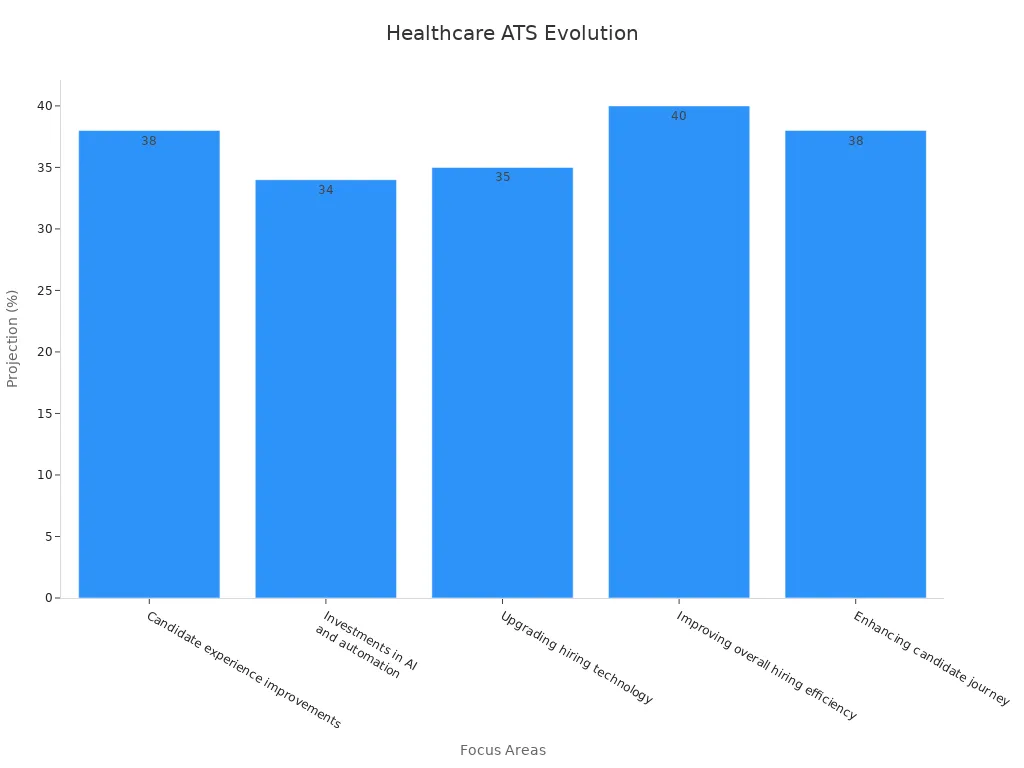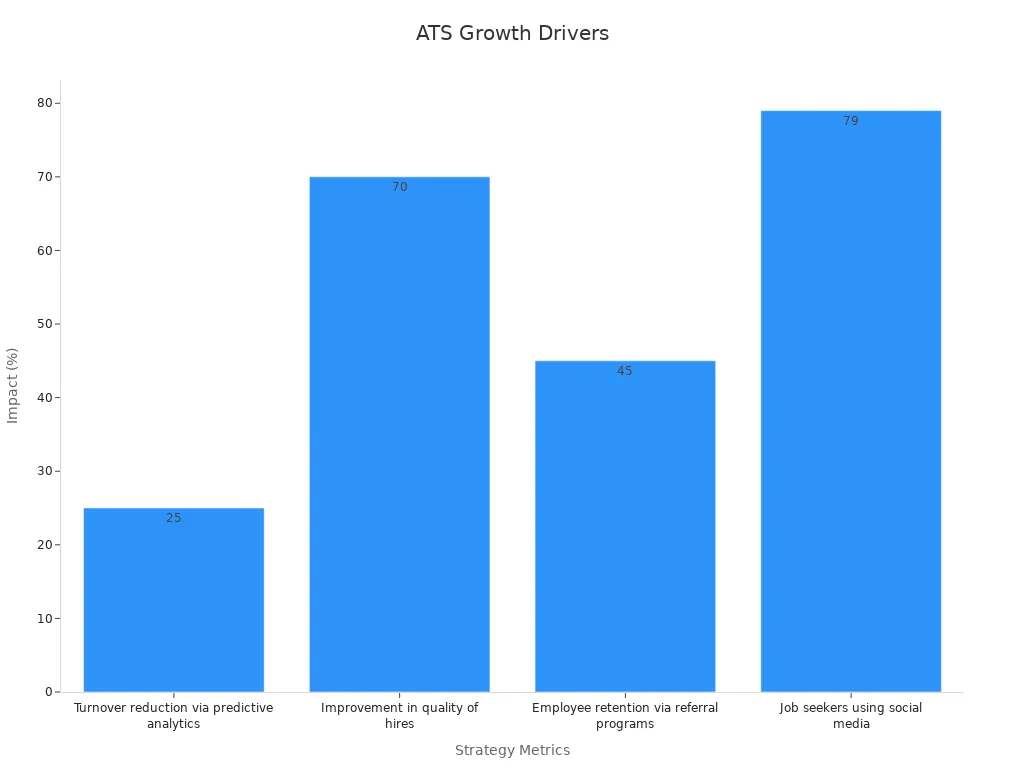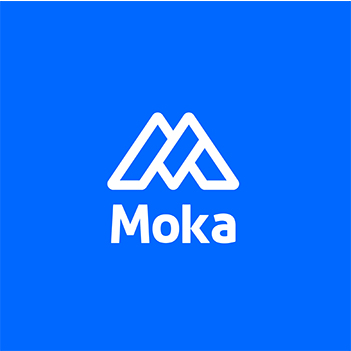Emerging Trends Shaping Healthcare Applicant Tracking Systems in 2025

Healthcare applicant tracking systems in 2025 are changing fast. Healthcare groups want to hire faster and find good workers. New trends show a future with better ATS, more automated steps, and using data to hire people. The chart below shows how spending on applicant tracking systems and focusing on candidate experience help shape healthcare hiring in the future.

Market Trends in Healthcare Applicant Tracking Systems
Growth Drivers in Healthcare
Healthcare applicant tracking systems are growing quickly in 2025. The ATS market is getting bigger because healthcare groups want to hire faster. Hospitals and clinics need more workers, and there may be 3.2 million open jobs by 2026. This makes healthcare groups look for special job tools like symplr Recruiting. The ATS market could be worth $6.2 billion by 2031.
Business Size | ATS Adoption Rate | Impact Metrics on Hiring Process |
|---|---|---|
Large businesses (1000+ employees) | ~90% | 66% of hiring managers report time-to-hire reduced by at least a week |
Mid-sized companies | ~70% | 52% report increased candidate satisfaction with automated communications |
Small businesses (<100 employees) | >45% | 61% say more data-driven hiring decisions due to ATS |
Using predictive analytics in applicant tracking systems helps lower turnover by 25%. Better recruitment tools help companies hire better people 70% of the time. Referral programs help keep workers longer, up to 45% more. Most job seekers, about 79%, use social media to find healthcare jobs. Digital recruitment is now very important.
Adoption Across Care Settings
Applicant tracking systems are now important in all healthcare places. Hospitals, clinics, elder care, and drug companies use ATS to handle many job applications. These systems help make hiring easier and faster. The ats market keeps growing as more healthcare groups use automated steps, job boards, and easy dashboards to help with hiring.

Applicant tracking systems help healthcare hiring by keeping all candidate data in one place. They also post jobs automatically and help make better hiring choices using data. These new trends in healthcare recruiting software help groups keep good workers and give better care to patients while making hiring easier.
Technology in 2025 Applicant Tracking System
AI and Automation
In 2025, healthcare groups use AI and automation in their ATS. These tools help recruiters fill jobs faster. They also make sure teams have enough skilled workers. AI features in an applicant tracking system scan resumes and match candidates. They also set up interviews. This means less manual work and faster hiring.
AI and machine learning save recruiters lots of time each month. Automation sorts many applications every day. Predictive analytics help stop staff shortages by guessing future needs. These ats tools fit healthcare jobs and help groups use data to hire.
Metric Description | Numerical Value | Impact Description |
|---|---|---|
Reduction in hiring time | 60% | Automation cuts hiring time a lot |
Recruiters finding better workers | 79% | Most recruiters say candidate quality is better |
Improvement in performance and retention | 20% | Diversity tools help teams work better |
Time saved in recruiting teams per month | Hundreds of hours | Automation handles many applications well |
Analytics and Reporting
Modern ATS in healthcare use analytics and reporting to help hiring. These systems track things like time-to-fill, cost-per-hire, and compliance. Dashboards and trend tools help recruiters find problems and fix them.
A hospital in Texas used a modern ats and hired 41% faster. This shows that analytics and reporting help with faster hiring and better compliance. Modern ATS give more accurate reports than old systems. Data from these systems helps groups find better candidates and save money.
Company/Organization | Statistical Measure | Impact/Result |
|---|---|---|
IBM | 40% less time-to-hire | Faster hiring and better candidates |
Unilever | 50% lower recruitment costs | Saves money and keeps workers longer |
Vodafone | 50% less time-to-fill | Faster hiring cycle |
Afterpay | 25% less fraud | Better screening and more trust |
Mount Sinai Health System | 30% fewer readmissions | Better patient checks and care |
Starbucks | 30% more hires from underrepresented groups | More diversity and inclusion |
JPMorgan Chase | 30% lower recruiting costs | Cheaper hiring campaigns |
HubSpot | 50% more social media ad engagement | Better candidate sourcing and interest |
These numbers show how analytics and modeling in ATS make hiring better. They cut time and costs, improve candidate quality, and help with diversity. Healthcare ATS also use reports to check job boards, social media, and referrals.
Recruiters use reports to compare job ads and see how candidates respond. This helps make the candidate experience better. These tools help healthcare groups compete for talent.
Compliance Tools
Compliance is very important for healthcare groups using an ATS. In 2025, ATS platforms have built-in compliance tools. These help recruiters follow rules and keep data safe. Automated steps make sure every part of hiring meets laws and standards.
Applicant tracking systems' automated checks and credential checks make sure candidates are right for clinical jobs. These tools lower the risk of mistakes and help patient care.
Note: Compliance tools in new ats help healthcare groups avoid big fines and keep a good name. Easy dashboards and alerts help recruiters follow each step and stay compliant.
Reports in ATS also track compliance, like background checks and credential dates. This helps teams fix problems fast and keep high standards for safety and quality.
Integration and User Experience
System Interoperability
Healthcare groups want ATS platforms that work with other systems. Connecting with HR, clinical, and talent tools helps teams hire without extra steps. This makes less manual work for recruiters. They can spend more time finding good candidates for healthcare jobs. When ats platforms share data with electronic health records, hiring gets better. Real-time dashboards show all hiring activity in one spot. This makes it easy to track job posts, candidate progress, and compliance. Integration also lets recruiters use automated steps. This helps move candidates through hiring faster and keeps patient care strong.
Mobile and Candidate Engagement
Mobile features in ATS platforms change how healthcare hiring works. Candidates can apply, set up interviews, and get updates on any device. This makes things easier for candidates and helps healthcare groups reach more people. Recruiters use texting and video interviews to talk to candidates faster. Studies show 76% of firms hiring travel nurses spend more on engagement tech. Instant messages on phones help recruiters reach candidates quickly. Video stories and job boards on social media get up to 5% more engagement. Promoting jobs by team brings 70% more candidate engagement than single ads. These ideas help healthcare teams fill jobs faster and find the best workers for patient care.
Engagement Strategy | Measurable Impact |
|---|---|
Mobile communication | Higher candidate response rates |
Video testimonials | 3%-5% more engagement |
Team-based job promotion | 70% more candidate engagement |
Impact on Healthcare Hiring

Efficiency and Speed
Modern ATS platforms help healthcare hiring by doing boring tasks automatically. Hospitals and clinics can fill jobs faster because ats systems post jobs, check resumes, and set up interviews. Automated steps and built-in scheduling tools make setting up interviews up to 80% quicker. Most healthcare groups say their hiring got better and faster after using ATS technology.
Doing hiring tasks automatically makes hiring go faster.
AI matching helps pick better candidates more quickly.
Better analytics give tips to keep improving.
Candidate Experience
Making things better for candidates is now very important in healthcare hiring. ATS platforms put all applications, interviews, and messages in one place, so candidates feel noticed and know what is happening. Healthcare groups use analytics to check how fast they reply, what interviewers say, and how much candidates join in. Many employers make forms easier and use mobile features to get more people to apply. Automated updates and personal emails keep candidates in the loop during hiring. In 2024, over half of U.S. employers made online forms shorter, and more than 75% of big groups used ats to make candidate experience better. Getting feedback and using data helps improve hiring and makes candidates happier.
Tip: Checking how happy candidates are and how many accept offers helps healthcare groups make hiring better.
Compliance and Quality
New ATS systems help with rules and quality in healthcare hiring. These platforms work with background check and credential tools to keep records current. Regular checks and monthly reviews make sure there are no rule problems. ats tools help stop hiring people who are not qualified and lower the chance of fines. Features like keeping data longer, tracking certificates, and following ISO rules help meet laws. Automation tools spot rule problems and make records for audits, so healthcare groups can keep high standards. Clear rules for paperwork and strong data safety keep privacy and trust in every part of hiring.
Same checks and steps for all candidates.
Automation helps with rule checks when hiring many people.
Clear records and safe data for easy audits.
Healthcare applicant tracking system trends in 2025 are changing fast. Automation, AI, and using data are growing a lot. Groups should use easy tools and automatic steps to hire people. Predictive analytics help find the right workers for the future. Checking your current system helps you stay ahead. This also helps healthcare groups give better care to patients. These changes make hiring better for everyone.
FAQ
What makes healthcare applicant tracking systems different from general ATS platforms?
Healthcare applicant tracking systems have job postings just for healthcare. They use automated steps and special compliance tools. These features help healthcare groups hire the right people fast.
How do applicant tracking systems improve candidate experience in healthcare recruiting?
Applicant tracking systems have easy dashboards and work on phones. They also connect with social media. These tools make things easier for candidates and help teams use data to hire.
Why should healthcare organizations use automated workflows in their recruiting processes?
Automated workflows help hire people faster and cut down on manual work. This lets teams spend more time on patient care. They also help manage talent better and make hiring results stronger.
See Also
Ways Applicant Tracking Systems Improve Hiring Process Clarity
Insider Tips On Applicant Tracking Systems For Career Growth
Using Applicant Tracking Systems To Spot Top Talent Easily
Top Ten Applicant Tracking System Features Every Recruiter Needs
Enhancing Employee Onboarding Through Data And Tracking Systems
From recruiting candidates to onboarding new team members, MokaHR gives your company everything you need to be great at hiring.
Subscribe for more information

